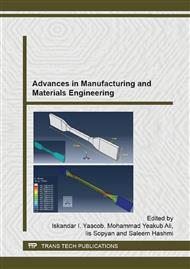[1]
K. H. Badri, A. H. Ujar, Z. Othman & F. H. Sahaldin. 2006. Shear strength of wood to wood adhesive based on palm kernel oil. Journal of Applied Polymer Science, 100(3): 1759 - 1764.
DOI: 10.1002/app.23015
Google Scholar
[2]
C. Wayakron Phetphaisit, R. Bumee, J. Namahoot, J. Ruamcharoen, P. Ruamcharoen. 2013. Polyurethane polyester elastomer: Innovative environmental friendly wood adhesive from modified PETs and hydroxyl liquid natural rubber polyols. International Journal of Adhesion & Adhesives, 41: 127–131.
DOI: 10.1016/j.ijadhadh.2012.11.007
Google Scholar
[3]
S. Chuayjuljit, T. Sangpakdee & O. Saravari. 2007. Processing and Properties of Palm Oil-Based Rigid Polyurethane Foam. Journal of Metals, Materials and Minerals, 17(1): 17-23.
Google Scholar
[4]
Z. K. S. Norin, T. L. Ooi. & A. Salmiah. 2006. Production of moulded palm-based flexible polyurethane foams. Journal of Oil Palm Research. 18: 198-203.
Google Scholar
[5]
Bernama. (2009, October 29). Government to Establish National Innovation Centre. Retrieve from: http: /www. pmo. gov. my.
Google Scholar
[6]
Z. Petrovic, I. Javni, A. Guo & W. Zhang. 2004. Method of making natural oil based polyols and polyurethanes therefrom. United States Patent.
Google Scholar
[7]
C. Wang, Y. Wang, W. Liu, H. Yin, Z. Yuan, Q. Wang, H. Xie & R. Cheng. 2012. Natural fibrous nanoclay reinforced soy polyol-based polyurethane. Materials Letters. 78: 85–87.
DOI: 10.1016/j.matlet.2012.03.067
Google Scholar
[8]
L. Kin-tak, G. Chong & H. David. 2006. A critical review on nanotube and nanotube/nanoclay related polymer composite materials. Composites: Part B. 37: 425–436.
DOI: 10.1016/j.compositesb.2006.02.020
Google Scholar
[9]
H. Dodiuk, I. Belinski, A. Dotan, & S. Kenig, 2006. Polyurethane adhesives containing functionalized nanoclays. Journal of Adhesion Science and Technology, 20(12):. 1345–1355.
DOI: 10.1163/156856106778456573
Google Scholar
[10]
M. A. Bhattab, J. Donate-Robles, V. Garcia-Pacios & J. Miguel Martin-Martinez. 2011. Characterization of polyurethane adhesives containing nanosilicas of different particle size. International Journal of Adhesion & Adhesives. 31: 97–103.
DOI: 10.1016/j.ijadhadh.2010.11.001
Google Scholar
[11]
N. Sarier & E. Onder. 2010. Organic modification of montmorillonite with low molecular weight polyethylene glycols and its use in polyurethane nanocomposite foams. Thermochimica Acta. 510: 113–121.
DOI: 10.1016/j.tca.2010.07.004
Google Scholar
[12]
C. Esposito. Corione, P. Prinari, D. Cannoletta, G. Mensitieri & A. Maffezzoli. 2008. Synthesis and characterization of clay-nanocomposite solvent-based polyurethane adhesive. International Journal of Adhesion and Adhesives, 28: 91-100.
DOI: 10.1016/j.ijadhadh.2006.12.004
Google Scholar
[13]
E. Gunister, I. Cobanoglu & I. Sevim. 2009. The effect of polyurethane on NaMt and ONaMt dispersions. Progress in Organic Coatings. 65: 357–361.
DOI: 10.1016/j.porgcoat.2009.02.005
Google Scholar
[14]
X. Kong, G. Liu & J. M. Curtis. 2011. Characterization of canola oil based polyurethane wood adhesives. International Journal of Adhesion & Adhesives. 31: 559–564.
DOI: 10.1016/j.ijadhadh.2011.05.004
Google Scholar
[15]
E. Sancaktar & J. Kuznicki. 2011. Nanocomposite adhesives: Mechanical behavior with nanoclay . International Journal of Adhesion & Adhesives. 31: 286–300.
DOI: 10.1016/j.ijadhadh.2010.09.006
Google Scholar
[16]
Ganesh. C. Basak, Abhijit Bandyopadhyay & Anil. K. Bhowmick. 2011. Influence of nanoclay on adhesion of EPDM vulcanizate. International Journal of Adhesion & Adhesives. 31: 209–219.
DOI: 10.1016/j.ijadhadh.2011.02.001
Google Scholar
[17]
U. Faheem. 2008. Clays, nanoclays, and montmorillonite minerals. Metallurgical And Materials Transactions A. 39(A): 2804- 2805.
Google Scholar
[18]
K.V.P. Chakradhar, K. Venkata Subbaiah2, M. Ashok Kumar & G. Ramachandra Reddy. 2011. Epoxy/polyester blend nanocomposites: effect of nanoclay on mechanical, thermal and morphological properties. Malaysian Polymer Journal. 6(2): 109-118.
Google Scholar
[19]
D.Y. Kwok & A.W. Neumann. 1999. Contact angle measurement and contact angle interpretation. Advances in Colloid and Interface Science. 81: 167-249.
DOI: 10.1016/s0001-8686(98)00087-6
Google Scholar
[20]
Anon. The Clay Mineral Group, Home Page: www. mineral. galleries. com, accessed July. 20, 2014, p.1–2.
Google Scholar


